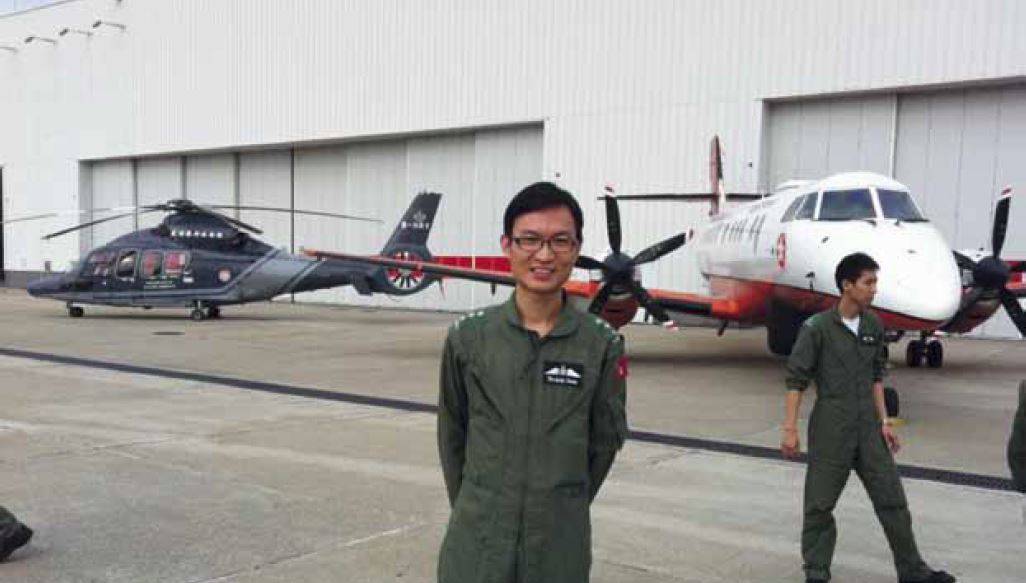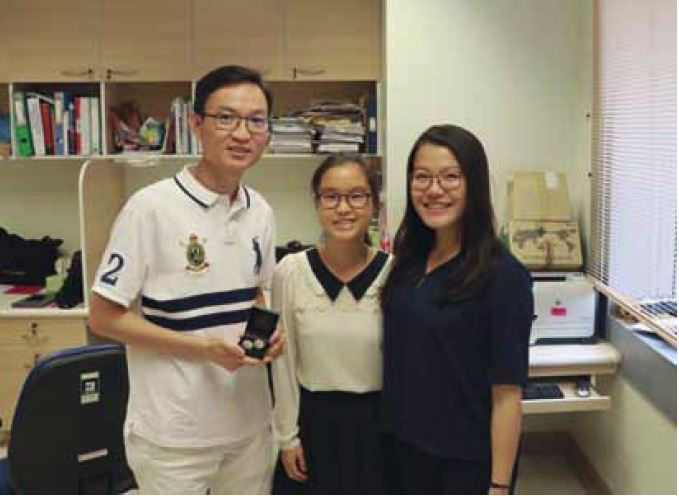© Hong Kong Academy of Medicine. CC BY-NC-ND 4.0
DOCTOR FOR SOCIETY
Part of a larger whole: serving in the Government
Flying Service. An interview with Dr Ralph Cheung
Michelle Tsui; Bianca Chan
Year 3 (MB ChB), The Chinese University of Hong
Kong, Hong Kong
“Was there an especially riveting case that you
could share with us?” we asked Dr Ralph Koon-ho Cheung, an emergency
medicine specialist, as we kick-started the interview at his office in
Prince of Wales’ Hospital. Dr Cheung has served as an Air Medical Officer
in the Government Flying Service for the past 12 years and has helped
hundreds of citizens in the line of duty. Aviation services are often
associated with dire, life-on-the-line situations, so we were expecting
riveting tales of heroic rescues and adrenaline-pumping missions from the
doctor.
Dr Cheung laughed. Real life in the aviation
services is far from being so dramatic. It is more like an extension of
our health care system for those without easy access to government clinics
and hospitals. On Mondays, Fridays, and public holidays, Government Flying
Service crewman are accompanied by a voluntary Air Medical Officer. Along
with 35 other Officers, Dr Cheung typically works one shift per month.
“It really isn’t as exciting as it is depicted in
the movies,” said Dr Cheung, lightly brushing off his contributions within
the team. Most of the missions are Casualty Evacuation, or CASEVAC, which
facilitates delivery of patients by helicopter from outlying islands to
hospitals in urban areas. Depending on the how critical the conditions
are, the helicopter may land directly on a helipad on Pamela Youde
Nethersole Eastern Hospital or on Wanchai Parking Apron where an ambulance
can transfer patients to Queen Mary Hospital or Ruttonjee Hospital. The
remaining missions are Search and Rescue, in which the team helps to
locate individuals in inaccessible areas such as on hills or even in the
waters of the South China Sea.
As we continued with our discussion, it slowly
became clear to us that this is not a celebratory tale of personal triumph
and individual largesse. There are no medals of valour or headline-worthy
stories to share. In fact, most cases that Dr Cheung has seen were typical
of those seen in any other emergency department, such as acute coronary
syndromes, metabolic disorders, heat stroke, or trauma. Yet, it is the
humdrum of such routine work that makes these officers most honourable.
This is, instead, a tale of hard work and collaboration, written in the
sweat of crewmen who toil laboriously to maintain the comprehensive health
care system that Hong Kong prides itself in. Although Dr Cheung attempted
to downplay his role, a busy day on shift for the air medical officer
involves half-eaten lunches and sweat-soaked uniform as crewmen receive
call after call. A new mission may come midway during an operation, and
the helicopter has to fly off immediately after a patient drop-off.
We cannot help but wonder, given the similarities
between the nature of his community service and that of his daily
practice, what motivated Dr Cheung to join the Government Flying Service.
Without the allure of ‘solving exotic problems’ that comes with
volunteering in developing countries, nor the boast-worthy reputation of
‘helping the underprivileged’ by providing free medical services, why
would Dr Cheung choose to, essentially, extend his work week? The father
of two did not give a specific reason; instead, he stressed the importance
of delivering health care to the doorstep of those geographical minorities
who are cut off from our urban hospital network. There are over 260
outlying islands in Hong Kong, and the Government Flying Service is a
vital lifeline that links the residents of those islands to eminent
clinics and hospitals.
In face of such a heavy workload, collaboration
within the team is key. While Air Medical Officers are busy managing
patients onboard, it is the crewmen who rush patients quickly and safely
to hospitals. With deeper understanding of weather conditions, and more
experience in searching, it is also the crewmen who identify where to
land, sometimes even winching down to transport the patient aboard.
Meanwhile, Air Medical Officers attend to the immediate health needs of
patients, so that the crewmen can concentrate on basic flight operations.
If cases are critical or if there are no nearby landing spots, Air Medical
Officers and crewmen winch down together to reach the patient. Together,
they share the race against time. Above everything, it is the camaraderie
they share. From post-mission discussions of the prior cases, or chats
about the workplace, the companionship is apparent through the littlest of
routines.
We ended the interview by asking Dr Cheung whether
there are any takeaways that he could share with us. “Well,” the doctor
replied, “I certainly have a firmer grasp of geography and aviation now.”
The humbleness in his voice made it clear that Dr Cheung has no wishes of
painting himself as a hero-to-the-rescue. Throughout our brief meeting, he
repeatedly emphasised on the importance of his team members and diminished
his own contributions to missions. And perhaps this is what true service
is about: leaving the idea of ‘self’ behind to identify as part of a
larger group.



